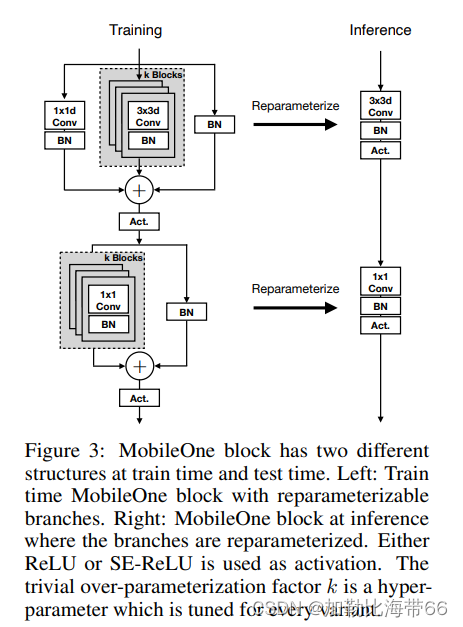
>>>深度学习Tricks,第一时间送达<<<
目录
1.MobileOne: 移动端仅需1ms的高性能骨干!
论文题目:An Improved One millisecond Mobile Backbone
论文地址:http://An Improved One millisecond Mobile Backbone

一般用于移动设备的高效神经网络骨干通常针对 FLOP 或参数计数等指标进行优化。然而,当部署在移动设备上时,这些指标可能与网络的延迟没有很好的相关性。因此,我们通过在移动设备上部署多个移动友好网络来对不同指标进行广泛分析。我们识别和分析最近高效神经网络中的架构和优化瓶颈,并提供缓解这些瓶颈的方法。为此,我们设计了一个高效的骨干 MobileOne,其变体在 iPhone12 上的推理时间低于 1 毫秒,在 ImageNet 上的 top-1 准确率为 75.9%。我们展示了 MobileOne 在高效架构中实现了SOTA性能,同时在移动设备上速度提高了许多倍。我们最好的模型在 ImageNet 上获得了与 MobileFormer 相似的性能,同时速度提高了 38 倍。我们的模型在 ImageNet 上的 top-1 准确率比 EfficientNet 在相似的延迟下高 2.3%。此外,我们展示了我们的模型可以推广到多个任务——图像分类、目标检测和语义分割,与部署在移动设备上的现有高效架构相比,延迟和准确度显著提高。
MobileOne(≈MobileNetV1+RepVGG+训练Trick)是由Apple公司提出的一种基于iPhone12优化的超轻量型架构,在ImageNet数据集上以<1ms的速度取得了75.9%的Top1精度!!!
2.MobileOne block网络模型:

3.源代码
import time
import torch.nn as nn
import numpy as np
import torch
import copy
def conv_bn(in_channels, out_channels, kernel_size, stride, padding, groups=1):
result = nn.Sequential()
result.add_module('conv', nn.Conv2d(in_channels=in_channels, out_channels=out_channels, kernel_size=kernel_size,
stride=stride, padding=padding, groups=groups, bias=False))
result.add_module('bn', nn.BatchNorm2d(num_features=out_channels))
return result
class DepthWiseConv(nn.Module):
def __init__(self, inc, kernel_size, stride=1):
super().__init__()
padding = 1
if kernel_size == 1:
padding = 0
# self.conv = nn.Sequential(
# nn.Conv2d(inc, inc, kernel_size, stride, padding, groups=inc, bias=False,),
# nn.BatchNorm2d(inc),
# )
self.conv = conv_bn(inc, inc, kernel_size, stride, padding, inc)
def forward(self, x):
return self.conv(x)
class PointWiseConv(nn.Module):
def __init__(self, inc, outc):
super().__init__()
# self.conv = nn.Sequential(
# nn.Conv2d(inc, outc, 1, 1, 0, bias=False),
# nn.BatchNorm2d(outc),
# )
self.conv = conv_bn(inc, outc, 1, 1, 0)
def forward(self, x):
return self.conv(x)
class MobileOneBlock(nn.Module):
def __init__(self, in_channels, out_channels, k, stride=1, dilation=1, padding_mode='zeros', deploy=False,
use_se=False):
super(MobileOneBlock, self).__init__()
self.deploy = deploy
self.in_channels = in_channels
self.out_channels = out_channels
self.deploy = deploy
kernel_size = 3
padding = 1
assert kernel_size == 3
assert padding == 1
self.k = k
padding_11 = padding - kernel_size // 2
self.nonlinearity = nn.ReLU()
if use_se:
# self.se = SEBlock(out_channels, internal_neurons=out_channels // 16)
...
else:
self.se = nn.Identity()
if deploy:
self.dw_reparam = nn.Conv2d(in_channels=in_channels, out_channels=in_channels, kernel_size=kernel_size,
stride=stride, padding=padding, dilation=dilation, groups=in_channels,
bias=True, padding_mode=padding_mode)
self.pw_reparam = nn.Conv2d(in_channels=in_channels, out_channels=out_channels, kernel_size=1, stride=1,
bias=True)
else:
# self.rbr_identity = nn.BatchNorm2d(num_features=in_channels) if out_channels == in_channels and stride == 1 else None
# self.rbr_dense = conv_bn(in_channels=in_channels, out_channels=out_channels, kernel_size=kernel_size, stride=stride, padding=padding, groups=groups)
# self.rbr_1x1 = conv_bn(in_channels=in_channels, out_channels=out_channels, kernel_size=1, stride=stride, padding=padding_11, groups=groups)
# print('RepVGG Block, identity = ', self.rbr_identity)
self.dw_bn_layer = nn.BatchNorm2d(in_channels) if out_channels == in_channels and stride == 1 else None
for k_idx in range(k):
setattr(self, f'dw_3x3_{k_idx}', DepthWiseConv(in_channels, 3, stride=stride))
self.dw_1x1 = DepthWiseConv(in_channels, 1, stride=stride)
self.pw_bn_layer = nn.BatchNorm2d(in_channels) if out_channels == in_channels and stride == 1 else None
for k_idx in range(k):
setattr(self, f'pw_1x1_{k_idx}', PointWiseConv(in_channels, out_channels))
def forward(self, inputs):
if self.deploy:
x = self.dw_reparam(inputs)
x = self.nonlinearity(x)
x = self.pw_reparam(x)
x = self.nonlinearity(x)
return x
if self.dw_bn_layer is None:
id_out = 0
else:
id_out = self.dw_bn_layer(inputs)
x_conv_3x3 = []
for k_idx in range(self.k):
x = getattr(self, f'dw_3x3_{k_idx}')(inputs)
# print(x.shape)
x_conv_3x3.append(x)
x_conv_1x1 = self.dw_1x1(inputs)
# print(x_conv_1x1.shape, x_conv_3x3[0].shape)
# print(x_conv_1x1.shape)
# print(id_out)
x = id_out + x_conv_1x1 + sum(x_conv_3x3)
x = self.nonlinearity(self.se(x))
# 1x1 conv
if self.pw_bn_layer is None:
id_out = 0
else:
id_out = self.pw_bn_layer(x)
x_conv_1x1 = []
for k_idx in range(self.k):
x_conv_1x1.append(getattr(self, f'pw_1x1_{k_idx}')(x))
x = id_out + sum(x_conv_1x1)
x = self.nonlinearity(x)
return x
# Optional. This improves the accuracy and facilitates quantization.
# 1. Cancel the original weight decay on rbr_dense.conv.weight and rbr_1x1.conv.weight.
# 2. Use like this.
# loss = criterion(....)
# for every RepVGGBlock blk:
# loss += weight_decay_coefficient * 0.5 * blk.get_cust_L2()
# optimizer.zero_grad()
# loss.backward()
def get_custom_L2(self):
# K3 = self.rbr_dense.conv.weight
# K1 = self.rbr_1x1.conv.weight
# t3 = (self.rbr_dense.bn.weight / ((self.rbr_dense.bn.running_var + self.rbr_dense.bn.eps).sqrt())).reshape(-1, 1, 1, 1).detach()
# t1 = (self.rbr_1x1.bn.weight / ((self.rbr_1x1.bn.running_var + self.rbr_1x1.bn.eps).sqrt())).reshape(-1, 1, 1, 1).detach()
# l2_loss_circle = (K3 ** 2).sum() - (K3[:, :, 1:2, 1:2] ** 2).sum() # The L2 loss of the "circle" of weights in 3x3 kernel. Use regular L2 on them.
# eq_kernel = K3[:, :, 1:2, 1:2] * t3 + K1 * t1 # The equivalent resultant central point of 3x3 kernel.
# l2_loss_eq_kernel = (eq_kernel ** 2 / (t3 ** 2 + t1 ** 2)).sum() # Normalize for an L2 coefficient comparable to regular L2.
# return l2_loss_eq_kernel + l2_loss_circle
...
# This func derives the equivalent kernel and bias in a DIFFERENTIABLE way.
# You can get the equivalent kernel and bias at any time and do whatever you want,
# for example, apply some penalties or constraints during training, just like you do to the other models.
# May be useful for quantization or pruning.
def get_equivalent_kernel_bias(self):
# kernel3x3, bias3x3 = self._fuse_bn_tensor(self.rbr_dense)
# kernel1x1, bias1x1 = self._fuse_bn_tensor(self.rbr_1x1)
# kernelid, biasid = self._fuse_bn_tensor(self.rbr_identity)
# return kernel3x3 + self._pad_1x1_to_3x3_tensor(kernel1x1) + kernelid, bias3x3 + bias1x1 + biasid
dw_kernel_3x3 = []
dw_bias_3x3 = []
for k_idx in range(self.k):
k3, b3 = self._fuse_bn_tensor(getattr(self, f"dw_3x3_{k_idx}").conv)
# print(k3.shape, b3.shape)
dw_kernel_3x3.append(k3)
dw_bias_3x3.append(b3)
dw_kernel_1x1, dw_bias_1x1 = self._fuse_bn_tensor(self.dw_1x1.conv)
dw_kernel_id, dw_bias_id = self._fuse_bn_tensor(self.dw_bn_layer, self.in_channels)
dw_kernel = sum(dw_kernel_3x3) + self._pad_1x1_to_3x3_tensor(dw_kernel_1x1) + dw_kernel_id
dw_bias = sum(dw_bias_3x3) + dw_bias_1x1 + dw_bias_id
# pw
pw_kernel = []
pw_bias = []
for k_idx in range(self.k):
k1, b1 = self._fuse_bn_tensor(getattr(self, f"pw_1x1_{k_idx}").conv)
# print(k1.shape)
pw_kernel.append(k1)
pw_bias.append(b1)
pw_kernel_id, pw_bias_id = self._fuse_bn_tensor(self.pw_bn_layer, 1)
pw_kernel_1x1 = sum(pw_kernel) + pw_kernel_id
pw_bias_1x1 = sum(pw_bias) + pw_bias_id
return dw_kernel, dw_bias, pw_kernel_1x1, pw_bias_1x1
def _pad_1x1_to_3x3_tensor(self, kernel1x1):
if kernel1x1 is None:
return 0
else:
return torch.nn.functional.pad(kernel1x1, [1, 1, 1, 1])
def _fuse_bn_tensor(self, branch, groups=None):
if branch is None:
return 0, 0
if isinstance(branch, nn.Sequential):
kernel = branch.conv.weight
bias = branch.conv.bias
running_mean = branch.bn.running_mean
running_var = branch.bn.running_var
gamma = branch.bn.weight
beta = branch.bn.bias
eps = branch.bn.eps
else:
assert isinstance(branch, nn.BatchNorm2d)
# if not hasattr(self, 'id_tensor'):
input_dim = self.in_channels // groups # self.groups
if groups == 1:
ks = 1
else:
ks = 3
kernel_value = np.zeros((self.in_channels, input_dim, ks, ks), dtype=np.float32)
for i in range(self.in_channels):
if ks == 1:
kernel_value[i, i % input_dim, 0, 0] = 1
else:
kernel_value[i, i % input_dim, 1, 1] = 1
self.id_tensor = torch.from_numpy(kernel_value).to(branch.weight.device)
kernel = self.id_tensor
running_mean = branch.running_mean
running_var = branch.running_var
gamma = branch.weight
beta = branch.bias
eps = branch.eps
std = (running_var + eps).sqrt()
t = (gamma / std).reshape(-1, 1, 1, 1)
return kernel * t, beta - running_mean * gamma / std
def switch_to_deploy(self):
dw_kernel, dw_bias, pw_kernel, pw_bias = self.get_equivalent_kernel_bias()
self.dw_reparam = nn.Conv2d(in_channels=self.pw_1x1_0.conv.conv.in_channels,
out_channels=self.pw_1x1_0.conv.conv.in_channels, kernel_size=self.dw_3x3_0.conv.conv.kernel_size,
stride=self.dw_3x3_0.conv.conv.stride, padding=self.dw_3x3_0.conv.conv.padding,
groups=self.dw_3x3_0.conv.conv.in_channels, bias=True, )
self.pw_reparam = nn.Conv2d(in_channels=self.pw_1x1_0.conv.conv.in_channels,
out_channels=self.pw_1x1_0.conv.conv.out_channels, kernel_size=1, stride=1, bias=True)
self.dw_reparam.weight.data = dw_kernel
self.dw_reparam.bias.data = dw_bias
self.pw_reparam.weight.data = pw_kernel
self.pw_reparam.bias.data = pw_bias
for para in self.parameters():
para.detach_()
self.__delattr__('dw_1x1')
for k_idx in range(self.k):
self.__delattr__(f'dw_3x3_{k_idx}')
self.__delattr__(f'pw_1x1_{k_idx}')
if hasattr(self, 'dw_bn_layer'):
self.__delattr__('dw_bn_layer')
if hasattr(self, 'pw_bn_layer'):
self.__delattr__('pw_bn_layer')
if hasattr(self, 'id_tensor'):
self.__delattr__('id_tensor')
self.deploy = True
class MobileOne(nn.Module):
def __init__(self, blocks, ks, channels, strides, width_muls, num_classes, deploy=False):
super().__init__()
self.stage_num = len(blocks)
# self.stage0 = MobileOneBlock(3, int(channels[0] * width_muls[0]), ks[0], stride=strides[0], deploy=deploy)
self.stage0 = nn.Sequential(nn.Conv2d(4, int(channels[0] * width_muls[0]), 3, 2, 1, bias=False),
nn.BatchNorm2d(int(channels[0] * width_muls[0])), nn.ReLU(), )
in_channels = int(channels[0] * width_muls[0])
for idx, block_num in enumerate(blocks[1:]):
idx += 1
module = []
out_channels = int(channels[idx] * width_muls[idx])
for b_idx in range(block_num):
stride = strides[idx] if b_idx == 0 else 1
block = MobileOneBlock(in_channels, out_channels, ks[idx], stride, deploy=deploy)
in_channels = out_channels
module.append(block)
setattr(self, f"stage{idx}", nn.Sequential(*module))
self.avg_pool = nn.AdaptiveAvgPool2d(1)
self.fc1 = nn.Sequential(nn.Linear(out_channels, num_classes, ), )
def forward(self, x):
# for s_idx in range(self.stage_num):
# x = getattr(self, f'stage{s_idx}')(x)
x0 = self.stage0(x)
# print(x0[0,:,0,0])
# return x0
x1 = self.stage1(x0)
x2 = self.stage2(x1)
x3 = self.stage3(x2)
x4 = self.stage4(x3)
x5 = self.stage5(x4)
x = self.avg_pool(x5)
x = torch.flatten(x, start_dim=1) # b, c
x = self.fc1(x)
return x
def make_mobileone_s0(num_classes,deploy=False):
blocks = [1, 2, 8, 5, 5, 1]
strides = [2, 2, 2, 2, 1, 2]
ks = [4, 4, 4, 4, 4, 4] if deploy is False else [1, 1, 1, 1, 1, 1]
width_muls = [0.75, 0.75, 1, 1, 1, 2] # 261 M flops
channels = [64, 64, 128, 256, 256, 512, 512]
model = MobileOneNet(blocks, ks, channels, strides, width_muls, num_classes, deploy)
return model
def repvgg_model_convert(model: torch.nn.Module, do_copy=True, input=None, output=None):
if do_copy:
model = copy.deepcopy(model)
for module in model.modules():
if hasattr(module, 'switch_to_deploy'):
module.switch_to_deploy()
print('swith done. Checking....')
deploy_model = make_mobileone_s0(26,deploy=True)
deploy_model.eval()
deploy_model.load_state_dict(model.state_dict())
if input is not None:
o = deploy_model(x)
# print(o)
# print(output)
print((output - o).sum())
# if save_path is not None:
# torch.save(model.state_dict(), save_path)
return deploy_model
if __name__ == '__main__':
model = make_mobileone_s0(num_classes=4)#.cuda(0)
model.eval()
data = torch.rand(1, 4, 128, 128)#.cuda(0)
for i in range(10):
start = time.time()
out = model(data)
print('time', time.time() - start, out.size())如何结合YOLOv5,有需要且感兴趣的小伙伴关注互粉一下,一起学习!共同进步!
关于YOLO改进及论文投稿可关注并留言博主的CSDN/QQ
>>>一起交流!互相学习!共同进步!<<<
文章出处登录后可见!
已经登录?立即刷新
